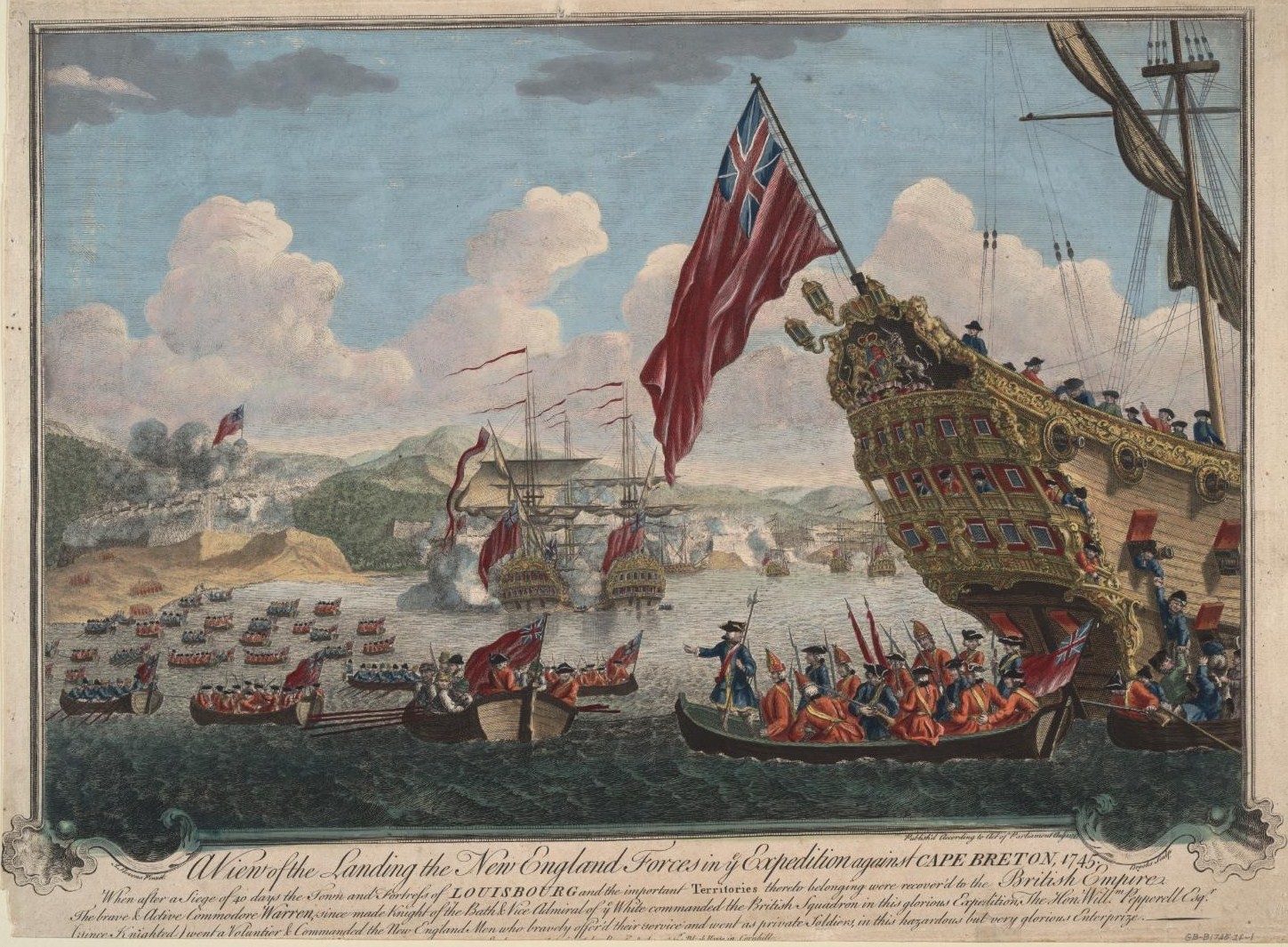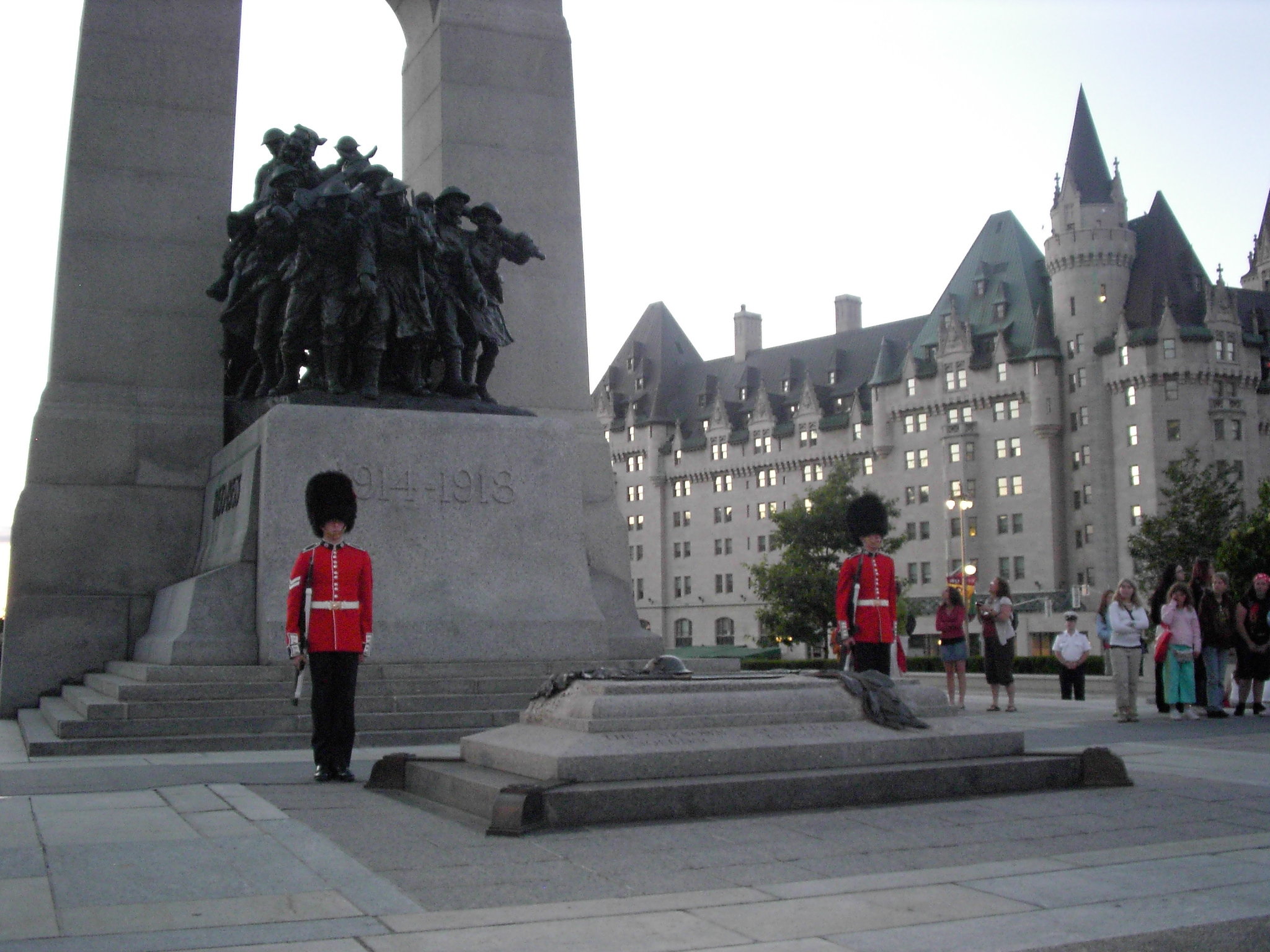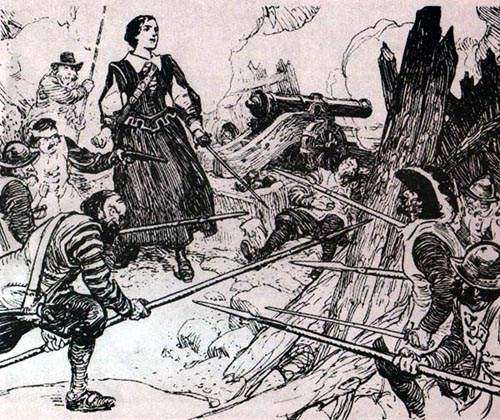|
Raid On Canso
The Raid on Canso was an attack by French forces from Louisbourg on the British outpost Fort William Augustus at Canso, Nova Scotia shortly after war declarations opened King George's War. The French raid was intended to boost morale, secure Louisbourg's supply lines with the surrounding Acadian settlements, and deprive Britain of a base from which to attack Louisbourg. There were 50 English families in the settlement. While the settlement was utterly destroyed, the objective failed, since the British launched an attack on Louisbourg in 1745, using Canso as a staging area. Background The inhabitants of Louisbourg received word of France's declaration of war on Great Britain on May 3, 1744. The colony had been facing dwindling provisions, a situation which was aggravated when the news of war brought the threat of British action cutting off the supply lines of Louisbourg. Under these circumstances, the continuance of the colony's provisioning necessitated military action. Furt ... [...More Info...] [...Related Items...] OR: [Wikipedia] [Google] [Baidu] |
King George's War
King George's War (1744–1748) is the name given to the military operations in North America that formed part of the War of the Austrian Succession (1740–1748). It was the third of the four French and Indian Wars. It took place primarily in the British provinces of Province of New York, New York, Province of Massachusetts Bay, Massachusetts Bay (which included Maine as well as Massachusetts at the time), Province of New Hampshire, New Hampshire (which included Vermont at the time), and Nova Scotia. Its most significant action was an expedition organized by Massachusetts Governor William Shirley that Siege of Louisbourg (1745), besieged and ultimately captured the French fortress of Louisbourg, on Cape Breton Island in Nova Scotia, in 1745. In French language, French, it is known as the ''Troisième Guerre Intercoloniale'' or Third Intercolonial War. The Treaty of Aix-la-Chapelle (1748), Treaty of Aix-la-Chapelle ended the war in 1748 and restored Louisbourg to France, but fail ... [...More Info...] [...Related Items...] OR: [Wikipedia] [Google] [Baidu] |
Naval Battle Off Tatamagouche
The action of 15 June 1745 (also known as the Battle of Famme Goose Bay) was a naval encounter between three New England vessels and a French and native relief convoy en route to relieve the Siege of Louisbourg (1745) during King George's War. The French and native convoy of four French vessels and fifty native canoes carrying 1200 fighters was led by Paul Marin de la Malgue and the New England forces were led by Captain David Donahew. The New Englanders were successful. The Governor of Ile Royal Louis Du Pont Duchambon thought that the New Englanders would have ended their siege of Louisbourg had Marin arrived. (There were 1800 French soldiers at Louisbourg versus 4200 New Englanders.) Instead, the day following the battle, Duchambon surrendered Louisbourg to New England. Background At the outbreak of the war, in May 1744, Captain David Donahue of the Resolution took prisoner the chief of the Mi'kmaq people of Ile Royale Jacques Pandanuques with his family to Boston. ... [...More Info...] [...Related Items...] OR: [Wikipedia] [Google] [Baidu] |
Acadian History
The Acadians (french: Acadiens , ) are an ethnic group descended from the French who settled in the New France colony of Acadia during the 17th and 18th centuries. Most Acadians live in the region of Acadia, as it is the region where the descendants of a few Acadians who escaped the Expulsion of the Acadians (aka The Great Upheaval / ''Le Grand Dérangement'') re-settled. Most Acadians in Canada continue to live in majority French-speaking communities, notably those in New Brunswick where Acadians and Francophones are granted autonomy in areas such as education and health. Acadia was one of the 5 regions of New France. Acadia was located in what is now Eastern Canada's Maritime provinces, as well as parts of Quebec and present-day Maine to the Kennebec River. It was ethnically, geographically and administratively different from the other French colonies and the French colony of Canada (modern-day Quebec). As a result, the Acadians developed a distinct history and culture. Th ... [...More Info...] [...Related Items...] OR: [Wikipedia] [Google] [Baidu] |
Military History Of Canada
The military history of Canada comprises hundreds of years of armed actions in the territory encompassing modern Canada, and interventions by the Canadian military in conflicts and peacekeeping worldwide. For thousands of years, the area that would become Canada was the site of sporadic intertribal conflicts among Aboriginal peoples. Beginning in the 17th and 18th centuries, Canada was the site of four colonial wars and two additional wars in Nova Scotia and Acadia between New France and New England; the conflicts spanned almost seventy years, as each allied with various First Nation groups. In 1763, after the final colonial war—the Seven Years' War—the British emerged victorious and the French civilians, whom the British hoped to assimilate, were declared "British Subjects". After the passing of the Quebec Act in 1774, giving the Canadians their first charter of rights under the new regime, the northern colonies chose not to join the American Revolution and remained loyal to ... [...More Info...] [...Related Items...] OR: [Wikipedia] [Google] [Baidu] |
Military History Of New England
A military, also known collectively as armed forces, is a heavily armed, highly organized force primarily intended for warfare. It is typically authorized and maintained by a sovereign state, with its members identifiable by their distinct military uniform. It may consist of one or more military branches such as an army, navy, air force, space force, marines, or coast guard. The main task of the military is usually defined as defence of the state and its interests against external armed threats. In broad usage, the terms ''armed forces'' and ''military'' are often treated as synonymous, although in technical usage a distinction is sometimes made in which a country's armed forces may include both its military and other paramilitary forces. There are various forms of irregular military forces, not belonging to a recognized state; though they share many attributes with regular military forces, they are less often referred to as simply ''military''. A nation's military may ... [...More Info...] [...Related Items...] OR: [Wikipedia] [Google] [Baidu] |
Military History Of Acadia
A military, also known collectively as armed forces, is a heavily armed, highly organized force primarily intended for warfare. It is typically authorized and maintained by a sovereign state, with its members identifiable by their distinct military uniform. It may consist of one or more military branches such as an army, navy, air force, space force, marines, or coast guard. The main task of the military is usually defined as defence of the state and its interests against external armed threats. In broad usage, the terms ''armed forces'' and ''military'' are often treated as synonymous, although in technical usage a distinction is sometimes made in which a country's armed forces may include both its military and other paramilitary forces. There are various forms of irregular military forces, not belonging to a recognized state; though they share many attributes with regular military forces, they are less often referred to as simply ''military''. A nation's military may ... [...More Info...] [...Related Items...] OR: [Wikipedia] [Google] [Baidu] |
Military History Of Nova Scotia
Nova Scotia (also known as Mi'kma'ki and Acadia) is a Canadian province located in Canada's Maritimes. The region was initially occupied by Mi'kmaq. The colonial history of Nova Scotia includes the present-day Canadian Maritime provinces and the northern part of Maine (Sunbury County, Nova Scotia), all of which were at one time part of Nova Scotia. In 1763 Cape Breton Island and St. John's Island (now Prince Edward Island) became part of Nova Scotia. In 1769, St. John's Island became a separate colony. Nova Scotia included present-day New Brunswick until that province was established in 1784. (In 1765, the county of Sunbury was created, and included the territory of present-day New Brunswick and eastern Maine as far as the Penobscot River.) During the first 150 years of European settlement, the colony was primarily made up of Catholic Acadians, Maliseet and Mi'kmaq. During the latter seventy-five years of this time period, there were six colonial wars that took place in Nova S ... [...More Info...] [...Related Items...] OR: [Wikipedia] [Google] [Baidu] |
Province Of Massachusetts Bay
The Province of Massachusetts Bay was a colony in British America which became one of the thirteen original states of the United States. It was chartered on October 7, 1691, by William III and Mary II, the joint monarchs of the kingdoms of England, Scotland, and Ireland. The charter took effect on May 14, 1692, and included the Massachusetts Bay Colony, the Plymouth Colony, the Province of Maine, Martha's Vineyard, Nantucket, Nova Scotia, and New Brunswick; the Commonwealth of Massachusetts is the direct successor. Maine has been a separate state since 1820, and Nova Scotia and New Brunswick are now Canadian provinces, having been part of the colony only until 1697. The name Massachusetts comes from the Massachusett Indians, an Algonquian tribe. It has been translated as "at the great hill", "at the place of large hills", or "at the range of hills", with reference to the Blue Hills and to Great Blue Hill in particular. Background Colonial settlement of the shores o ... [...More Info...] [...Related Items...] OR: [Wikipedia] [Google] [Baidu] |
Siege Of Fort Anne
The siege of Annapolis Royal (also known as the siege of Fort Anne) in 1744 involved two of four attempts by the French, along with their Acadian and native allies, to regain the capital of Nova Scotia/Acadia, Annapolis Royal, during King George's War. The siege is noted for Governor of Nova Scotia Paul Mascarene successfully defending the last British outpost in the colony and for the first arrival of New England Ranger John Gorham to Nova Scotia. The French and Mi'kmaq land forces were thwarted on both attempts on the capital because of the failure of French naval support to arrive. Historical context The conquest of Acadia by Great Britain began with the 1710 capture of the provincial capital, Port Royal. In the 1713 Treaty of Utrecht, France formally ceded Acadia to Britain. However, there was disagreement about the provincial boundaries, and some Acadians also resisted British rule. With renewed war imminent in 1744, the leaders of New France formulated plans to reta ... [...More Info...] [...Related Items...] OR: [Wikipedia] [Google] [Baidu] |
William Shirley
William Shirley (2 December 1694 – 24 March 1771) was a British Army officer and colonial administrator who served as the governor of the British American colonies of Massachusetts Bay and the Bahamas. He is best known for his role in organizing the successful capture of Louisbourg during King George's War, and for his role in managing military affairs during the French and Indian War. He spent most of his years in the colonial administration of British North America working to defeat New France, but his lack of formal military training led to political difficulties and his eventual downfall. Politically well connected, Shirley began his career in Massachusetts as advocate general in the admiralty court, and quickly became an opponent of Governor Jonathan Belcher. He joined with Belcher's other political enemies to bring about Belcher's recall, and was appointed Governor of Massachusetts Bay in Belcher's place. He successfully quieted political divisions within the province ... [...More Info...] [...Related Items...] OR: [Wikipedia] [Google] [Baidu] |
John Bradstreet
Major General John Bradstreet, born Jean-Baptiste Bradstreet (21 December 1714 – 25 September 1774) was a British Army officer during King George's War, the French and Indian War, and Pontiac's War. He was born in Annapolis Royal, Nova Scotia to a British Army lieutenant and an Acadian mother. He also served as the Commodore-Governor for Newfoundland. Life Jean-Baptiste Bradstreet was the son of Agathe de Saint Etienne de La Tour and her first husband Edward Bradstreet. It is unknown whether he was related to Puritan Simon Bradstreet. Canadian National Biography, Retrieved 25 June 2016 Military service Through his Acadian mother's influence he was accepted into the regular British army in 1735. Bradstreet's early military service consisted o ...[...More Info...] [...Related Items...] OR: [Wikipedia] [Google] [Baidu] |
Private Man, 40th 1742
Private or privates may refer to: Music * "In Private", by Dusty Springfield from the 1990 album ''Reputation'' * Private (band), a Denmark-based band * "Private" (Ryōko Hirosue song), from the 1999 album ''Private'', written and also recorded by Ringo Sheena * "Private" (Vera Blue song), from the 2017 album ''Perennial'' Literature * ''Private'' (novel), 2010 novel by James Patterson * ''Private'' (novel series), young-adult book series launched in 2006 Film and television * ''Private'' (film), 2004 Italian film * ''Private'' (web series), 2009 web series based on the novel series * ''Privates'' (TV series), 2013 BBC One TV series * Private, a penguin character in ''Madagascar'' Other uses * Private (rank), a military rank * ''Privates'' (video game), 2010 video game * Private (rocket), American multistage rocket * Private Media Group, Swedish adult entertainment production and distribution company * ''Private (magazine)'', flagship magazine of the Private Media Group ... [...More Info...] [...Related Items...] OR: [Wikipedia] [Google] [Baidu] |








